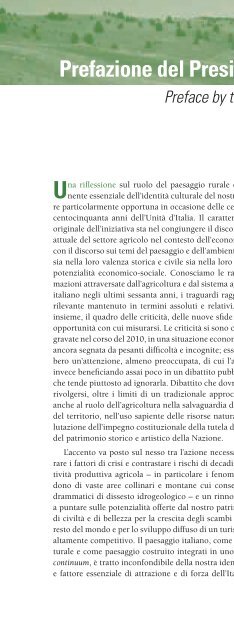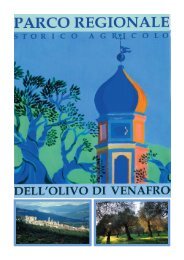Scarica il documento (1.51 MB) - Rete Rurale Nazionale
Scarica il documento (1.51 MB) - Rete Rurale Nazionale
Scarica il documento (1.51 MB) - Rete Rurale Nazionale
Create successful ePaper yourself
Turn your PDF publications into a flip-book with our unique Google optimized e-Paper software.
Prefazione del Presidente della Repubblica<br />
Preface by the President of the Italian Republic<br />
Una riflessione sul ruolo del paesaggio rurale come componente<br />
essenziale dell’identità culturale del nostro paese appare<br />
particolarmente opportuna in occasione delle celebrazioni dei<br />
centocinquanta anni dell’Unità d’Italia. Il carattere distintivo e<br />
originale dell’iniziativa sta nel congiungere <strong>il</strong> discorso sullo stato<br />
attuale del settore agricolo nel contesto dell’economia nazionale<br />
con <strong>il</strong> discorso sui temi del paesaggio e dell’ambiente, considerati<br />
sia nella loro valenza storica e civ<strong>il</strong>e sia nella loro dimensione e<br />
potenzialità economico-sociale. Conosciamo le radicali trasformazioni<br />
attraversate dall’agricoltura e dal sistema agroalimentare<br />
italiano negli ultimi sessanta anni, i traguardi raggiunti, <strong>il</strong> peso<br />
r<strong>il</strong>evante mantenuto in termini assoluti e relativi. Ed è chiaro,<br />
insieme, <strong>il</strong> quadro delle criticità, delle nuove sfide e delle nuove<br />
opportunità con cui misurarsi. Le criticità si sono certamente aggravate<br />
nel corso del 2010, in una situazione economica mondiale<br />
ancora segnata da pesanti difficoltà e incognite; esse richiederebbero<br />
un’attenzione, almeno preoccupata, di cui l’agricoltura sta<br />
invece beneficiando assai poco in un dibattito pubblico, in Italia,<br />
che tende piuttosto ad ignorarla. Dibattito che dovrebbe in effetti<br />
rivolgersi, oltre i limiti di un tradizionale approccio settoriale,<br />
anche al ruolo dell’agricoltura nella salvaguardia dell’ambiente e<br />
del territorio, nell’uso sapiente delle risorse naturali, nella rivalutazione<br />
dell’impegno costituzionale della tutela del paesaggio e<br />
del patrimonio storico e artistico della Nazione.<br />
L’accento va posto sul nesso tra l’azione necessaria per superare<br />
i fattori di crisi e contrastare i rischi di decadimento dell’attività<br />
produttiva agricola – in particolare i fenomeni di abbandono<br />
di vaste aree collinari e montane cui conseguono eventi<br />
drammatici di dissesto idrogeologico – e un rinnovato impegno<br />
a puntare sulle potenzialità offerte dal nostro patrimonio storico<br />
di civ<strong>il</strong>tà e di bellezza per la crescita degli scambi tra l’Italia e <strong>il</strong><br />
resto del mondo e per lo sv<strong>il</strong>uppo diffuso di un turismo di qualità<br />
altamente competitivo. Il paesaggio italiano, come paesaggio naturale<br />
e come paesaggio costruito integrati in uno straordinario<br />
continuum, è tratto inconfondib<strong>il</strong>e della nostra identità nazionale<br />
e fattore essenziale di attrazione e di forza dell’Italia anche nel<br />
A reflection on the role of the rural landscape as an<br />
essential component of the cultural identity of our<br />
country seems especially appropriate on the occasion<br />
of the celebration of the hundred and fiftieth<br />
anniversary of the unification of Italy. The distinctiveness<br />
and originality of this initiative is that it<br />
links the issue of the present state of the farming<br />
sector in the national economy to the issue of landscape<br />
and the environment. In so doing, it sees agriculture<br />
together with landscape and environment<br />
in terms of their historical and civ<strong>il</strong> value as well as<br />
their economic and social dimension and potential.<br />
We are well aware of how radically Italian agriculture<br />
and the whole food-production system have<br />
changed over the last sixty years, the goals they<br />
have reached, and their ongoing importance in both<br />
absolute and relative terms. It is no less clear that<br />
there are critical issues to be dealt with as well as<br />
new challenges and new opportunities.The critical<br />
issues have certainly become worse in the course of<br />
2010, in a world economic situation st<strong>il</strong>l marked by<br />
grave difficulties and uncertainties They should be<br />
an object of attention, indeed of concern; instead,<br />
agriculture, rather than be a matter for much public<br />
discussion in Italy, is generally ignored altogether.<br />
The question should not be approached in a traditionally<br />
sectorial fashion; the role of agriculture must<br />
be recognized in safeguarding the environment and<br />
the land through a wise use of natural resources and<br />
a new emphasis on the Italian Constitution’s commitment<br />
to protecting the landscape of the nation<br />
and its historical and artistic heritage.<br />
Stress needs to be placed on how the measures that<br />
must be taken to deal with the crisis and the risk of<br />
a decline in farming production – notably as a result<br />
of the abandonment of vast h<strong>il</strong>l and mountain areas,<br />
which brings in its wake dramatic events due to the<br />
ensuing hydrogeological instab<strong>il</strong>ity – can be linked<br />
with a renewed commitment to place our stakes on<br />
the potential offered by our historical heritage of<br />
culture and beauty for the growth of exchanges between<br />
Italy and the rest of the world and the widespread<br />
development of a highly competitive quality<br />
tourism.<br />
The Italian landscape, as an integration of the natural<br />
and the constructed landscape into an extraordinary<br />
continuum, is an unmistakable feature of our<br />
V



